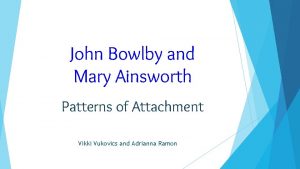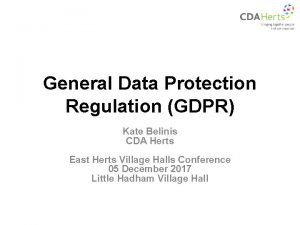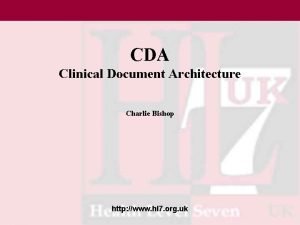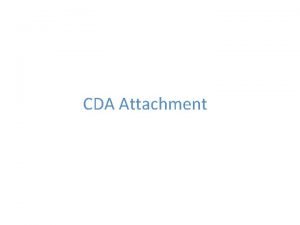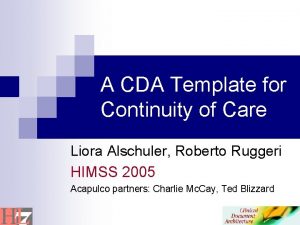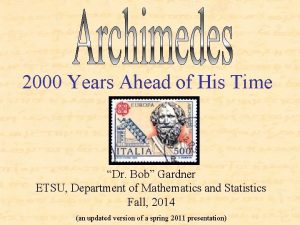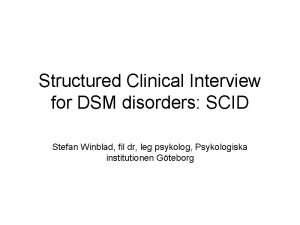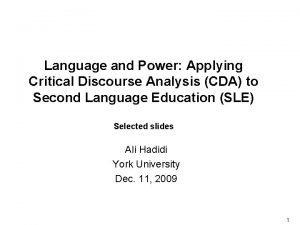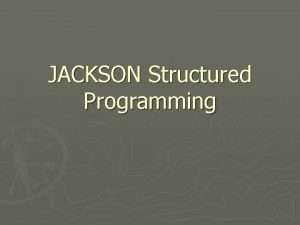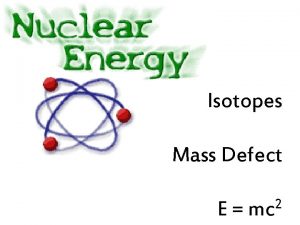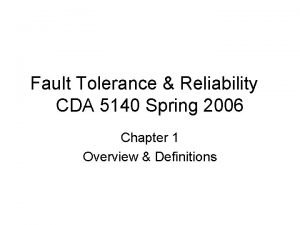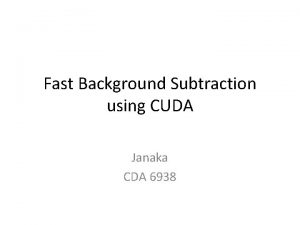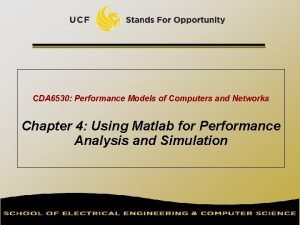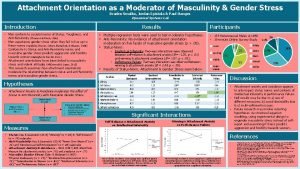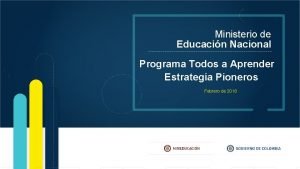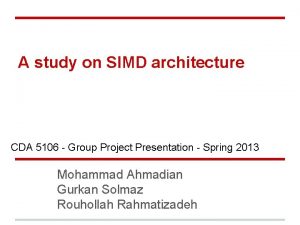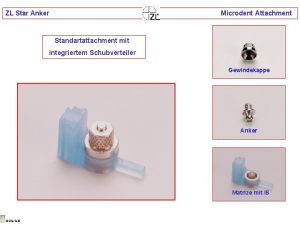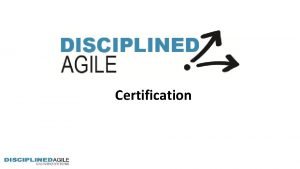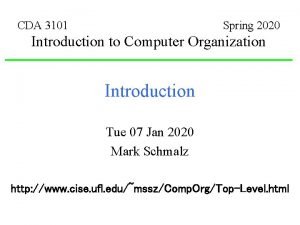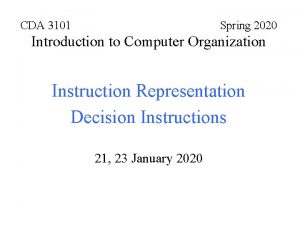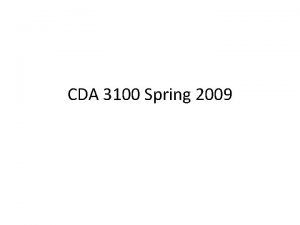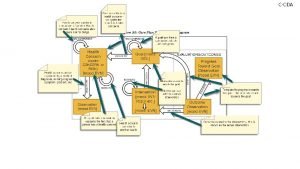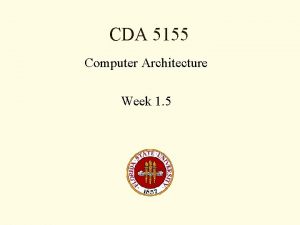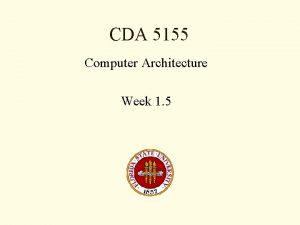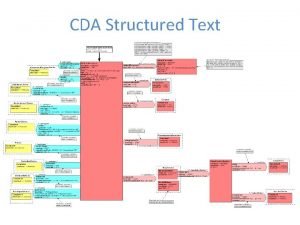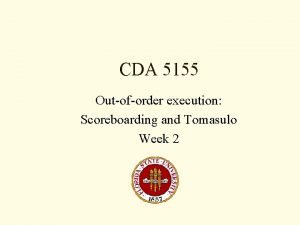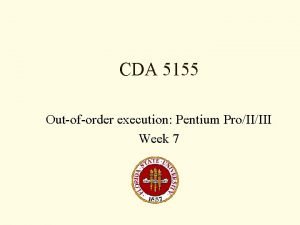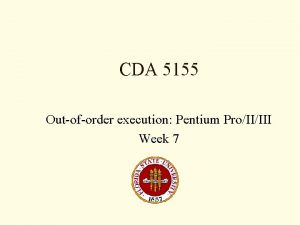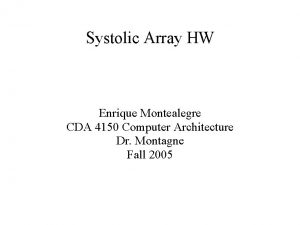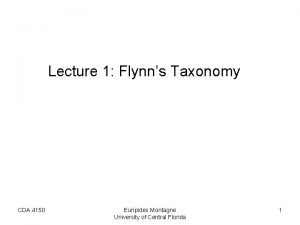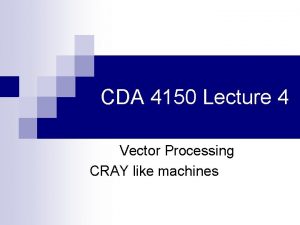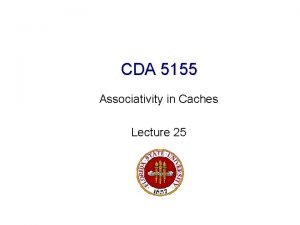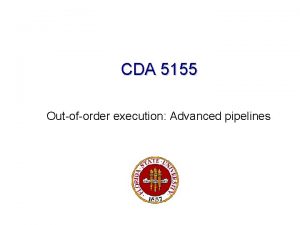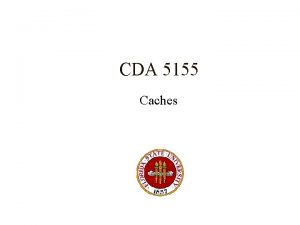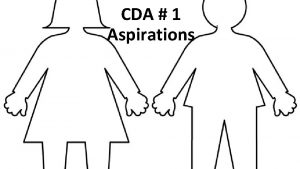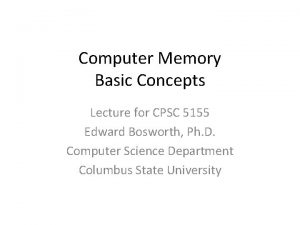CDA 5155 and 4150 Computer Architecture Week 2
















































- Slides: 48

CDA 5155 and 4150 Computer Architecture Week 2: 2 September 2014

Goals of the course • Advanced coverage of computer architecture – general purpose processors, embedded processors, historically significant processors, design tools. – Instruction set architecture – Processor microarchitecture – Systems architecture • Memory systems • I/O systems 2/49

Teaching Staff • Professor Gary Tyson – Ph. D: University of California – Davis – Faculty jobs: • • • California State University Sacramento: 1987 - 1990 University of California – Davis: 1993 - 1994 University of California – Riverside: 1995 - 1996 University of Michigan: 1997 - 2003 Florida State University: 2003 – present 3/49

Grading in 5155 (Fall’ 14) Programming assignments Exams (2 @ 25% each) In class, 75 minutes Team Project (20%) In-order pipeline simulation (10%) Out-of-order pipeline simulation (10%) 3 or 4 students per team Class Participation (10%) 4/49

Time Management • 3 hours/week lecture – This is probably the most important time • 2 hours/week reading – Hennessy/Patterson: – Computer Architecture: A Quantitative Approach • 3 -5 hours/week exam prep • 5+ hours/week Project (1/3 semester) Total: ~10 -15 hours per week. 5/49

Week Tentative Course Timeline Date Topic 1 Aug 28 Performance, ISA, Pipelining 2 Sept 2 Pipelining, Branch Prediction 3 Sept 9 Superscalar, Exceptions 4 Sept 16 Compilers, VLIW 5 Sept 23 Dynamic Scheduling 6 Sept 30 Dynamic Scheduling 7 Oct 7 Advanced pipelines 8 Oct 14 Advanced pipelines 9 Oct 21 Cache design 10 Oct 28 Cache design, VM 11 Nov 4 Multiprocessor, Multithreading 12 Nov 11 Embedded processors 13 Nov 18 Embedded processors 14 Nov 25 Research Topics 15 Dec 2 Research Topics Holidays Due Dates Notes Exam project 6/49

Web Resources Course Web Page: http: //www. cs. fsu. edu/~tyson/courses/CDA 5155 Wikipedia: http: //en. wikipedia. org/wiki/Microprocessor Wisconsin Architecture Page: http: //arch-www. cs. wisc. edu/home 7/49

Levels of Abstraction • • • Problem/Idea (English? ) Algorithm (pseudo-code) High-Level languages (C, Verilog) Assembly instructions (OS calls) Machine instructions (I/O interfaces) Microarchitecture/organization (block diagrams) Logic level: gates, flip-flops (schematic, HDL) Circuit level: transistors, sizing (schematic, HDL) Physical: VLSI layout, feature size, cabling, PC boards. What are the abstractions at each level? 8/49

Levels of Abstraction • • • Problem/Idea (English? ) Algorithm (pseudo-code) High-Level languages (C, Verilog) Assembly instructions (OS calls) Machine instructions (I/O interfaces) Microarchitecture/organization (block diagrams) Logic level: gates, flip-flops (schematic, HDL) Circuit level: transistors, sizing (schematic, HDL) Physical: VLSI layout, feature size, cabling, PC boards. At what level do I perform a square root? Recursion? 9/49

Levels of Abstraction • • • Problem/Idea (English? ) Algorithm (pseudo-code) High-Level languages (C, Verilog) Assembly instructions (OS calls) Machine instructions (I/O interfaces) Microarchitecture/organization (block diagrams) Logic level: gates, flip-flops (schematic, HDL) Circuit level: transistors, sizing (schematic, HDL) Physical: VLSI layout, feature size, cabling, PC boards. Who/what translates from one level to the next? 10/49

Role of Architecture • Responsible for hardware specification: – Instruction set design • Also responsible for structuring the overall implementation – Microarchitectural design. • Interacts with everyone – mainly compiler and logic level designers. • Cannot do a good job without knowledge of both sides 11/49

Design Issues: Performance • Get acceptable performance out of system. – Scientific: floating point throughput, memory&disk intensive, predictable – Commercial: string handling, disk (databases), predictable – Multimedia: specific data types (pixels), network? Predictable? – Embedded: what do you mean by performance? – Workstation: Maybe all of the above, maybe not 12/49

Calculating Performance • • • Execution time is often the best metric Throughput (tasks/sec) vs. latency (sec/task) Benchmarks: what are the tasks? – – – What I care about! Representative programs (SPEC, Linpack) Kernels: representative code fragments Toy programs: useful for testing end-conditions Synthetic programs: does nothing but with a representative instruction mix. 13/49

Design Issues: Cost • Processor – Die size, packaging, heat sink? Gold connectors? – Support: fan, connectors, motherboard specifications, etc. • Calculating processor cost: – Cost of device = (die + package + testing) / yield – Die cost = wafer cost / good die yield • Good die yield related to die size and defect density – Support costs: direct costs (components, labor), indirect costs ( sales, service, R&D) – Total costs amortized over number of systems sold(PC vs NASA) 14/49

Other design issues • Some applications care about other design issues. • NASA deep space mission – Reliability: software and hardware (radiation hardening) • AMD – Code compatibility • ARM – Power 15/49

A Quantitative Approach • Hardware systems performance is generally easy to quantify – Machine A is 10% faster than Machine B – Of course Machine B’s advertising will show the opposite conclusion • Many software systems tend to have much more subjective performance evaluations. 16/49

Measuring Performance • Total Execution Time: – A is 3 times faster than B for programs P 1, P 2 1 n n Σ Time i=1 i – Issue: Emphasizes long running programs 17/49

Measuring Performance • Weighted Execution Time: n ∑ Weighti X Timei i=1 – What if P 1 is executed far more frequently? 18/49

Measuring Performance • Normalized Execution Time: – Compare machine performance to a reference machine and report a ratio. • SPEC ratings measure relative performance to a reference machine. 19/49

Amdahl’s Law • Rule of Thumb: Make the common case faster http: //en. wikipedia. org/wiki/Amdahl's_law (Attack longest running part until it is no longer) repeat 20/49

Instruction Set Design • Software Systems: named variables; complex semantics. • Hardware systems: tight timing requirements; small storage structures; simple semantics • Instruction set: the interface between very different software and hardware systems 21/49

Design decisions • How much “state” is in the microarchitecture? – Registers; Flags; IP/PC • How is that state accessed/manipulated? – Operand encoding • What commands are supported? – Opcode; opcode encoding 22/49

Design Challenges: or why is architecture still relevant? • Clock frequency is increasing – This changes the number of levels of gates that can be completed each cycle so old designs don’t work. – It also tend to increase the ratio of time spent on wires (fixed speed of light) • Power – Faster chips are hotter; bigger chips are hotter 23/49

Design Challenges (cont) • Design Complexity – More complex designs to fix frequency/power issues leads to increased development/testing costs – Failures (design or transient) can be difficult to understand (and fix) • We seem far less willing to live with hardware errors (e. g. FDIV) than software errors – which are often dealt with through upgrades – that we pay for!) 24/49

Techniques for Encoding Operands • Explicit operands: – Includes a field to specify which state data is referenced – Example: register specifier • Implicit operands: – All state data can be inferred from the opcode – Example: function return (CISC-style) 25/49

Accumulator • Architectures with one implicit register – Acts as source and/or destination – One other source explicit • Example: C = A + B – Load A – Add B – Store C // (Acc)umulator = A // Acc = Acc + B // C = Acc Ref: “Instruction Level Distributed Processing: Adapting to Shifting Technology” 26/49

Stack • Architectures with implicit “stack” – Acts as source(s) and/or destination – Push and Pop operations have 1 explicit operand • Example: C = A + B – – Push A Push B Add Pop C // Stack = {A} // Stack = {A, B} // Stack = {A+B} // C = A+B ; Stack = {} Compact encoding; may require more instructions though 27/49

Registers • Most general (and common) approach – Small array of storage – Explicit operands (register file index) • Example: C = A + B Register-memory load/store Load R 1, A Load R 2, B Add R 3, R 1, R 2 Store R 3, C 28/49

Memory • Big array of storage – More complex ways of indexing than registers • Build addressing modes to support efficient translation of software abstractions • Uses less space in instruction than 32 -bit immediate field A[i]; use base (i) + displacement (A) (scaled? ) a. ptr; use base (a) + displacement (ptr) 29/49

Addressing modes Register Immediate Base/Displacement Register Indirect Indexed Direct Memory Indirect Autoincrement Add R 4, R 3 Add R 4, #3 Add R 4, 100(R 1) Add R 4, (R 1+R 2) Add R 4, (1001) Add R 4, @(R 3) Add R 4, (R 2)+ 30/49

Other Memory Issues What is the size of each element in memory? 0 x 000 0 -255 Byte 0 x 000 0 - 65535 Half word 0 x 000 0 - ~4 B Word 31/49

Other Memory Issues Big-endian or Little-endian? Store 0 x 114488 FF Points to most significant byte 0 x 000 11 Points to least significant byte 0 x 000 FF 44 88 88 44 FF 11 32/49

Other Memory Issues Non-word loads? 0 x 000 11 ldb R 3, (000) 00 00 00 11 44 88 FF 33/49

Other Memory Issues Non-word loads? ldb R 3, (003) 11 FF FF 44 Sign extended 88 0 x 003 FF 34/49

Other Memory Issues Non-word loads? ldbu R 3, (003) 11 00 00 00 FF 44 Zero filled 88 0 x 003 FF 35/49

Other Memory Issues Alignment? Word accesses only address ending in 00 Half-word accesses only ending in 0 Byte accesses any address 11 44 0 x 002 ldw R 3, (002) is illegal! 88 FF Why is it important to be aligned? How can it be enforced? 36/49

Techniques for Encoding Operators • Opcode is translated to control signals that – direct data (MUX control) – select operation for ALU – Set read/write selects for register/memory/PC • Tradeoff between how flexible the control is and how compact the opcode encoding. – Microcode – direct control of signals (Improv) – Opcode – compact representation of a set of control signals. • You can make decode easier with careful opcode selection 37/49

Handling Control Flow • • • Conditional branches (short range) Unconditional branches (jumps) Function calls Returns Traps (OS calls and exceptions) Predicates (conditional retirement) 38/49

Encoding branch targets • PC-relative addressing – Makes linking code easier • Indirect addressing – Jumps into shared libraries, virtual functions, case/switch statements • Some unusual modes to simplify target address calculation – (segment offset) or (trap number) 39/49

Condition codes • Flags – Implicit: flag(s) specified in opcode (bgt) – Flag(s) set by earlier instructions (compare, add, etc. ) • Register – Uses a register; requires explicit specifier • Comparison operation – Two registers with compare operation specified in opcode. 40/49

Higher Level Semantics: Functions • Function call semantics – – • Save PC + 1 instruction for return Manage parameters Allocate space on stack Jump to function Simple approach: – Use a jump instruction + other instructions • Complex approach: – Build implicit operations into new “call” instruction 41/49

Role of the Compiler • Compilers make the complexity of the ISA (from the programmers point of view) less relevant. – Non-orthogonal ISAs are more challenging. – State allocation (register allocation) is better left to compiler heuristics – Complex Semantics lead to more global optimization – easier for a machine to do. People are good at optimizing 10 lines of code. Compilers are good at optimizing 10 M lines. 42/49

LC processor • Little Computer Fall 2011 – For programming projects • Instruction Set Design opcode reg. A reg. B dest. Reg 43/49

LC processor R-type instructions opcode reg. A 24 - 22 reg. B 21 - 19 18 – 16 add: dest. Reg 15 – 3 2 -0 dest. Reg = reg. A + reg. B nand: dest. Reg = reg. A & reg. B 44/49

LC processor I-type instructions opcode reg. A 24 - 22 reg. B 21 - 19 18 – 16 offset. Field 15 – 0 lw: reg. B = Memory[reg. A + offset. Field] sw: Memory[reg. A +offset. Field] = reg. B beq: if (reg. A= = reg. B) PC = PC + 1 + offset. Field 45/49

LC processor O-type instructions opcode unused 24 - 22 21 – 0 noop: do nothing halt: halt the simulation 46/49

LC assembly example lw 0 1 lw 1 2 start add 1 beq 0 0 noop done halt five. fill neg 1. fill st. Addr. fill five 3 2 1 2 start load reg 1 with 5 (uses symbolic address) load reg 2 with -1 (uses numeric address) decrement reg 1 goto end of program when reg 1==0 go back to the beginning of the loop end of program 5 -1 start will contain the address of start (2) 47/49

LC machine code example (address 0): 8454151 (hex 0 x 810007) (address 1): 9043971 (hex 0 x 8 a 0003) (address 2): 655361 (hex 0 xa 0001) (address 3): 16842754 (hex 0 x 1010002) (address 4): 16842749 (hex 0 x 100 fffd) (address 5): 29360128 (hex 0 x 1 c 00000) (address 6): 25165824 (hex 0 x 1800000) (address 7): 5 (hex 0 x 5) (address 8): -1 (hex 0 xffff) (address 9): 2 (hex 0 x 2) Input for simulator: 8454151 9043971 655361 16842754 16842749 29360128 25165824 5 -1 2 48/49
 Week by week plans for documenting children's development
Week by week plans for documenting children's development Difference between computer architecture and organization
Difference between computer architecture and organization Bus architecture in computer architecture
Bus architecture in computer architecture Flowchart for memory reference instructions
Flowchart for memory reference instructions Dazed and confused cda
Dazed and confused cda Call and return architecture in software engineering
Call and return architecture in software engineering Nicholas nickleby cda
Nicholas nickleby cda Cda competency statement 1 menu
Cda competency statement 1 menu Mary shelley cda
Mary shelley cda Kate cda
Kate cda Pacific rim2 cda
Pacific rim2 cda Charlie cda
Charlie cda The mime cda
The mime cda Hardware 1990 cda
Hardware 1990 cda What is cda?
What is cda? Palimpsest cda
Palimpsest cda Cda portfolio resources
Cda portfolio resources Redeemer film cda
Redeemer film cda Syzyfowe prace film cda
Syzyfowe prace film cda How can we integrate oop with sd/sa
How can we integrate oop with sd/sa Purpose of discourse analysis
Purpose of discourse analysis Jackson structured programming
Jackson structured programming Mass defect
Mass defect Zero tolerance cda
Zero tolerance cda Cuda cda
Cuda cda Cda basiconline
Cda basiconline Matrix 2 cda
Matrix 2 cda Gambler cda
Gambler cda Lady macbeth cda
Lady macbeth cda Cda analysis
Cda analysis But manitou cda
But manitou cda Hangman cda
Hangman cda Thanks for the victory
Thanks for the victory Titanic cda
Titanic cda Pvd partij
Pvd partij Cda programa todos a aprender
Cda programa todos a aprender Beowulf cda
Beowulf cda Cda mechanik
Cda mechanik Rrrrrrr cda
Rrrrrrr cda Cda 5106
Cda 5106 Zl anker
Zl anker Kapitał ludzki cda
Kapitał ludzki cda Double jeopardy cda
Double jeopardy cda G44 fdny
G44 fdny Disciplined agile consortium
Disciplined agile consortium Uf cda3101
Uf cda3101 Cda 3101
Cda 3101 Cda 3100
Cda 3100 Gol 3 cda
Gol 3 cda








